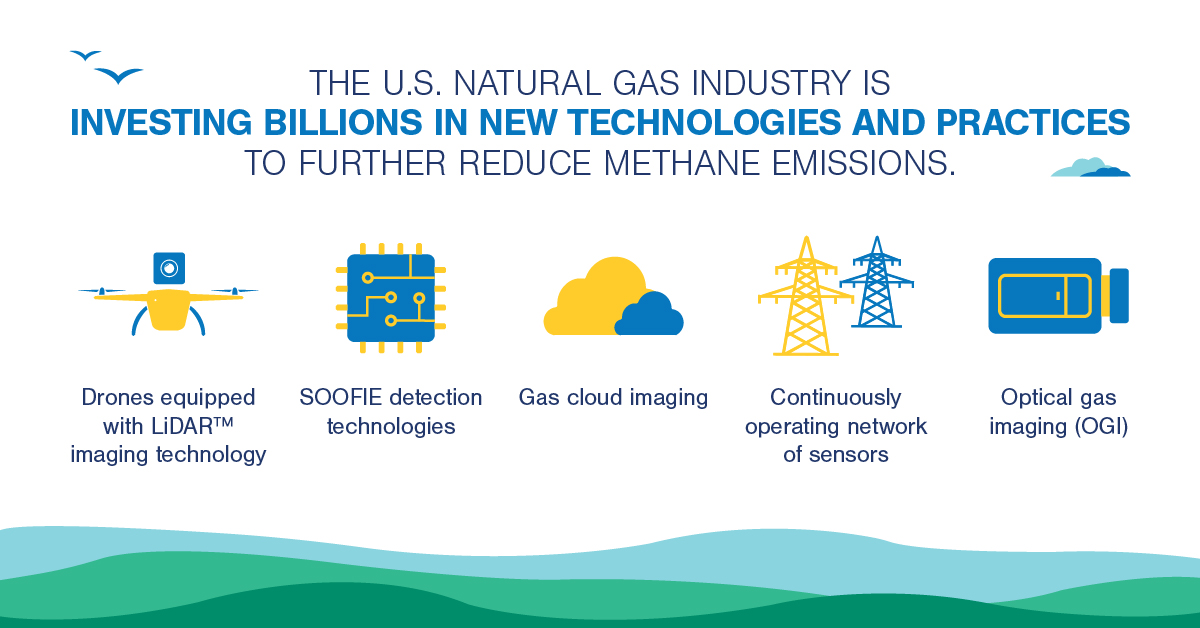
Learn more about Reducing Methane here.
- ConocoPhillips – Drones are the latest technology being piloted in ConocoPhillips’s arsenal of leak detection and repair (LDAR) tools, providing real-time identification of leaks and accurate quantification of leaks and process equipment emissions.
- EQT – EQT uses a number of practices and technologies to reduce methane emissions.
- Employs“green” completions technology, which transfers the natural gas at the wellhead to a separator immediately after well completion rather than flaring or venting the natural gas. In 2017, EQT used green completions technology for 100% of completed wells.
- Optical gas imaging (OGI) — In 2017, EQT used optical gas imaging (OGI) to monitor for leaks at more than 30% of compressor stations and dehydration facilities and 65% of unconventional wellpads.
- More than 90% of all leaks detected in production operations were repaired immediately.
- Beginning in 2018, EQT will perform OGI monitoring on every unconventional wellpad following Center for Responsible Shale Development standards.
- Equinor – Equinor supports methane regulations in the U.S. at the federal level and is utilizing innovative technical solutions, like methane “sniffing” drones to identify and address methane emissions. Between 2014 and 2018, Equinor reduced their US methane emissions by 80%.
- BP – BP supports the direct regulation of methane by the EPA and has a significant leak detection drone program underway in BP’s U.S. operations.
- BP announced the investment of $5 million in geospatial analytics company Satelytics, which uses advanced spectral imagery and machine learning to monitor methane emissions and other environmental changes.
- BPX Energy is now using drone-mounted leak detection technologies, which enable up to 1,500 well sites to be surveyed every month across all of its operating basins. The flights generate data around the location and size of a leak and issue a work order to fix it.
- In future BP-operated oil and gas processing projects, the company will deploy continuous measurement, including instruments such as gas cloud imaging, to measure methane emissions. Source: https://www.bp.com/en/global/corporate/news-and-insights/press-releases/bp-north-sea-deploys-mars-technology-in-world-first-methane-monitoring-project.html)
- BP – BP achieved zero net growth in operational emissions in 2018, a methane intensity of 0.2% and 2.5 million tonnes (MTe) of sustainable GHG emissions reductions activity since the beginning of 2016. BP has set a goal of reaching 3.5 million tonnes of sustainable GHG emissions reductions by 2025. Since 2000, BP’s U.S. onshore business, BPX Energy, has reduced its total GHG emissions by more than 2 million metric tons of carbon dioxide equivalent, with methane reductions accounting for most of the decline. That’s comparable to the annual electricity-related emissions of more than 300,000 typical American homes. Source: https://www.bp.com/en/global/corporate/news-and-insights/speeches/investing-in-a-cleaner-better-future.html
- Chevron – Chevron has set a goal to reduce flaring intensity by 25 to 30% and to reduce methane emissions intensity by 20 to 25% for the 2016-2023 time period. These new performance measures can be used to determine Chevron’s annual variable pay program that affects approximately 45,000 employees. Chevron is a founding member of The Environmental Partnership and The Collaboratory for Advancing Methane Science. We have reduced methane emissions from Chevron’s U.S. onshore production operations by 85 percent since 2013.Examples of emission reduction projects:
- Chevron has removed or retrofitted all continuous high-bleed pneumatic controllers from its onshore U.S. facilities.
- Chevron’s Leak Detection and Repair (LDAR) program drives a continuous learning process. In some areas, Integrated Operations Centers are used with systems that remotely detect leaks and losses from equipment.
- ExxonMobil- ExxonMobil is partnering with the University of Texas-Austin, the Environmental Defense Fund, Pioneer Natural Resources Co. and the Gas Technology Institute on the Project Astra Initiative to monitor methane emissions in the Permian Basin through a continuously-operating network of sensors.
Learn more about NGSA member actions in our blog post as well as our graphic Reaching Climate Goals with Natural Gas.
